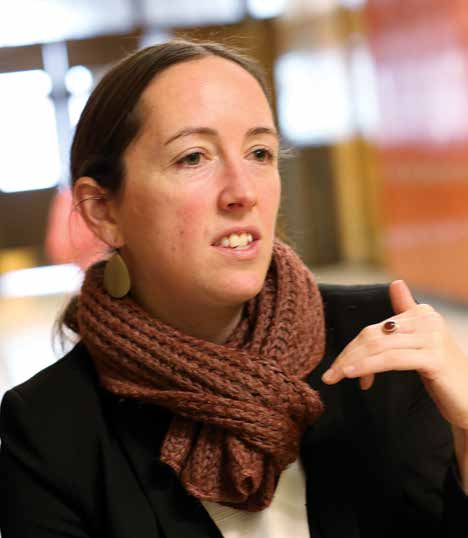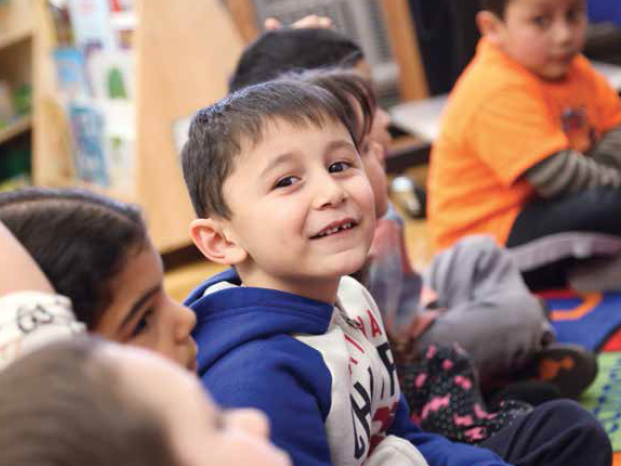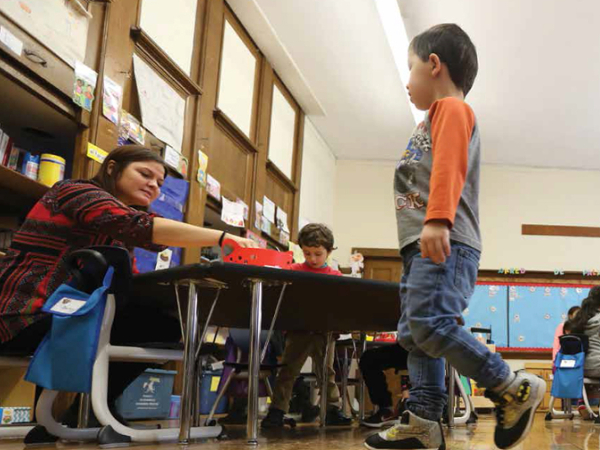Building a dual-immersion language program in Waltham public kindergarten
By Bethany Romano, MBA'17

At first glance, Sandra Quesada’s public kindergarten classroom in downtown Waltham looks much like any other: the walls are awash in primary colors, tiny desks are arranged in geometric pods, and half of the floor space is taken up by a soft blue rug, upon which are perched 20 fidgeting kindergartners in a lopsided circle. Together, they chant the days of the week, practice counting, sing songs and spell out simple words.
It’s lovely, and completely typical—except for the fact that those 20 kids and their teacher are all speaking Spanish.
This is the Waltham school district’s latest experiment: dual-immersion language instruction. The optional program launched in 2015 with 40 slots in two kindergarten classes. Over 100 families applied for the lottery, and there’s a lengthy waiting list. By all accounts, the program has been a massive success for the district and the families who enrolled their children here.
Kaytie Dowcett ’99, MPP’15, spent two years spearheading the effort to get this pilot program off the ground as a member of Waltham’s School Committee. Raised in the “Watch City” herself, Dowcett spent the first part of her career running after school programs in Boston and teaching in Waltham’s middle schools before earning her master’s in public policy degree at Heller, where she initially learned about the dual-immersion teaching model. After seeing her English language learner (ELL) students struggle to succeed in a standard educational environment, the concept of dual-immersion intrigued her.
“In this country, if you come to elementary school with a language other than English as your dominant language, it’s taught out of you,” says Dowcett. “They teach you English at the expense of your first language. Then you get to middle school and you’re expected to learn a world language, which is rather ironic. There’s some recognition that having a second language is a skill, an asset, but we haven’t been doing it right.”
Waltham, which has a large Spanish-speaking population, has been a linguistically, culturally and racially diverse city for decades. That diversity is often referred to as a strength, says Dowcett, “but we’re still learning how to tap into that strength, rather than just pay lip service to it. We say we value a multilingual community because being bilingual gives you access to more jobs, greater economic opportunity and it makes us better neighbors to one another. So why wait until middle school to teach a second language?
“If we can start that process earlier, why not? We’re saying that our diversity is an asset, so let’s really mean it, let’s operationalize it, let’s bring people from different linguistic and cultural backgrounds together and be deliberate about learning from each other.”

In addition to this desire to “walk the walk” in valuing linguistic diversity, Waltham is ideally positioned to start a dual-language program. The district is growing and needs to add a new school soon—plus, there’s no shortage of scientific research to support the benefits of dual-immersion instruction. Decades of studies indicate that Waltham should see improvements in academic performance for the children who participate, regardless of whether they speak Spanish or English at home.
Dual-immersion schools are built on a model of absolute inclusion for all students, regardless of their home language. Half of the students in the pilot program speak primarily Spanish at home, and the other half English. In school, Ms. Quesada delivers 80 percent of instruction in Spanish. The other 20 percent—special classes like drama, library, music and art—is taught in English.
A key component of the model, says Waltham’s director of English language learning, Catherine Carney, is ensuring that the program is completely equitable to that of any other public kindergarten class. “That means we have access to the same things any other school has, including specials, transportation, speech therapists, occupational therapists—any of the resources that other kindergarteners in the city have. It’s important to us because dual language instruction should be an add-on, not a trade-off.”
Right now, the dual-immersion program is housed in six rooms on the second floor of the Waltham Community and Cultural Center, a large, multistory red brick building perched on the corner of Moody Street in downtown Waltham. Marianne Duffy, the school’s interim director, says the program plans to grow. “Next year, the language split for rising first graders will shift to 70/30, and so on until they reach a 50/50 equilibrium in third grade. We’re building the program into a school one year at a time. There was easily enough demand in Waltham to justify a larger program, but we want to start small and do this right. We’re co-constructing this model as it evolves, and at the same time we’re co-constructing a school culture that is inclusive of everyone.”

The program shares its space with a number of small nonprofits, including the Waltham Partnership for Youth where Dowcett serves as executive director. In that role, she works to identify the needs of Waltham youth and leverage resources to meet those needs. A key component of her work is recognizing that systems and structures don’t always provide students with equal opportunities to succeed.
When Dowcett entered graduate school to get her first degree in education, she began to learn about systems of discrimination that exist at every level. “As early as kindergarten, teachers often unwittingly judge their students’ ability based on how they look, how well kept they are, whether their hygiene is good, whether they have an accent. That implicit bias has a direct and fairly strong impact on a student’s trajectory because first, teachers can make decisions about student placement, and second, the kids internalize those expectations and respond accordingly.”
“I did a lot of reading about implicit bias in education in graduate school, and it was like a hammer over my head. As a kid growing up in Waltham I definitely had a meritocratic mentality that if you work hard you’ll succeed. I came from a working class family and I worked hard and I was successful in school, and I wanted to pat myself on the back for that. But I could see that everything I was reading about had played out in my own K-12 education for many of my Puerto Rican classmates. I want to be part of a solution, not perpetuate that pattern.”
After leaving the classroom, Dowcett spent a lot of time studying instruction and program models at Heller, including the dual-immersion model. She says, “I thought ‘we should try to do this here.‘ I approached our superintendent and the ELL director, who both supported the idea. We decided to put together a study group to see if we could pull this off in Waltham, and we really dove in.”
During the two-year planning process, the team collected a lot of research on language instruction to build support at the district level and among families in the community. Seminal researchers in this field say that dual-immersion is the only model that has proven to close the academic achievement gap and the academic content gap between English learners and their native-English speaking peers.

Diana Serrano, a fourth-year Heller PhD student, became involved in the dual-language program as the subject of her dissertation. “When I applied to the PhD program,” she says, “I wanted to study ELL students, but it was hard to find data that I could analyze. I was beginning to think I would need to change my focus, study something else, when I learned that Waltham was in the process of building this program, and met Kaytie.”
In the planning process, Serrano helped Dowcett and her colleagues review and identify research to guide their decision-making. “Research has shown that when you promote learning in a child’s native language, it not only benefits their academic performance in their native language, it will also promote their performance in their non-native language. When you teach a child in their native language, they’ll be more successful, no matter how you measure success: in Spanish, in English, in engagement, in involvement. It’s a fascinating way to create a more inclusive environment, and there are so many good reasons to do it.”
Serrano also helped them create a truly random lottery process, which not only ensures fairness for families, but also creates an ideal scenario for Serrano to conduct her dissertation research using a natural social experiment. She says, “I’m interested in looking at the students’ developmental reading assessment scores over time and their individual proficiency over time. Since there was a lottery of randomly selected students and, in essence, a control group who didn’t get into the dual-immersion kindergarten, I can study whether these students are performing better. There’s a lot of research out there, as we’ve been discussing, but very little of it is truly experimental. Here, the conditions are just perfect for an experiment.”
While the role of research is crucial to inform Waltham’s dual-immersion program, there’s also a strong ethical imperative for promoting schools like these. Serrano says, “Rather than telling a child not to speak her language, that it isn’t important or that she can learn it later, imagine how impactful it must be for that child to instead be told ‘your language matters, your culture matters, and we want to learn from you, too.’ That kind of environment builds feelings of inclusiveness, acceptance, and self-esteem—and that helps children thrive.”
